Fracking good for the climate? What a load of hot air
November 30, 2012Chesapeake Appalachia Sentenced for Clean Water Act Violations
December 5, 2012By Alison Rose Levy, AlterNet, Nov. 30, 2012
The good news is that a public health department— New York State’s Department of Health (DOH)— is finally undertaking an assessment of fracking’s likely health risks. The bad news is that it’s questionable whether it will allow adequate time to do a credible and complete job. So says a new scientific watchdog group launched to assure that science, rather than expediency prevails.
Up until now government has relied on the gas industry’s blanket assurances of safety. The industry routinely tries to conflate the safety of vertical gas drilling (in use for a over a century) with horizontal fracking (in use for a little over a decade), a method which deploys a potent arsenal of chemicals so hazardous they defy known waste treatment methods.
Led by Dr. David O. Carpenter, director of the Institute for Health and the Environment at the University at Albany’s School of Public Health, the new group, Concerned Health Professionals of New York , represents hundreds of health professionals. (Others are welcome to join at their Web site.) Their goal is assuring that the Health Impact Assessment currently requested by New York’s Governor Andrew Cuomo, is comprehensive, complete and conducted transparently. And to help that process, they have compiled health research and reports on their Web site to make sure that there are no omissions.
Fracking’s Four Biggest Biophysical Risks
There are five areas of concern, detailed in the research the doctors have collated, about the biophysical risks.
1. Radioactive wastewater
The higher levels of radioactive materials, released through drilling from Marcellus shale, exceed EPA’s maximum contaminant safety levels by 1,000-fold. Due to infrequent testing, it’s unlikely that radioactivity in public water would be detected prior to mass consumption, with exposure resulting in “anemia, cataracts, cancer, and increased mortality,” according to a CDC toxicological profiles report .
2. Radon
With radon exposure, the second leading cause of lung cancer in the U.S., the radon present in the shale will readily mix with the gas and travel with it via pipeline into the homes and businesses of its end users.
3. Smog
Exhaust from trucks and industrial equipment increases smog in both rural locations and travels downstate to impair air quality in regional urban environments.
4. Chemical contamination of drinking water
Over time, most well casings fail. When fracking fluids seep from them to connect with underground fissures, previously abandoned wells, and natural faults and fractures, the contaminants and methane can readily migration over long distances into underground water ways and fresh drinking water sources.
Five Main Systemic Obstacles to Protecting Health From Fracking
In addition to the biophysical vectors, is the overarching context for assessing, preventing or treating the resulting diseases. To make an accurate assessment, it’s necessary to consider:
1. The long latency of many illnesses
A higher incidence of asthma, cancer, heart disease and the effects of endocrine disruption on developing fetuses and children, due to contaminant exposure, only become evident over time. To prevent disease rather than incur its high human and economic costs, it’s best to intervene prior to exposure, rather than act in hindsight.
2. The lack of medical know-how
Conventional medicine does not recognize, no less treat, symptoms and illnesses resulting from increasing toxic chemicals exposures. Treatment of cancer and radiation-related conditions is a medical specialty.
3. The conflicts of interests affecting scientific findings
According to studies cited in a 2012 meeting presentation before the NY DEC, industry-funded studies can result in findings that “benefit sponsors, (are based on) poor study design, and (withhold) negative data from publication.”



